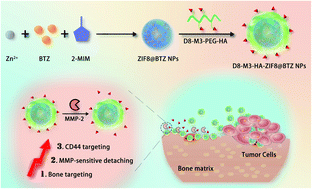Construction and evaluation of detachable bone-targeting MOF carriers for the delivery of proteasome inhibitors†
Abstract
Tumor bone metastasis is an important cause of tumor recurrence and death. Although bone-targeting nanoparticles decorated with targeting ligands have shown good affinity for bone tissues with the properties of adhesion to the bone matrix, it is not easy to detach from the surface of the bone matrix in the tumor-bone microenvironment, attributed to the robust coordination force between the targeting ligands, such as bisphosphates with bone-deposited calcium. This may hinder the transport of nanoparticles from bone tissue to bone metastatic tumors. In this research, we designed a bone-targeting nanocarrier with detachable bone-targeting character for the therapy of bone metastases. The nanoparticles were constructed by using ZIF-8 and bone-targeting and MMP enzyme sensitive polypeptide-modified hyaluronic acid as a carrier and proteasome inhibitor Bortezomib (BTZ) as cargo. The results show that the constructed D8-M3-HA-ZIF8@BTZ nanoparticles possessed several favorable properties such as good colloidal stability, acid-sensitive drug release, D8 peptide mediated bone targeting and MMP enzyme-responsive desorption. Besides, nanoparticle endocytosis and cytotoxicity were enhanced through HA-mediated targeting to CD44 over-expressing tumor cells. Altogether, this study provides a potential cascade targeting strategy for improving the delivery effects of bone targeted nanoparticles for the delivery of proteasome inhibitors.



 Please wait while we load your content...
Please wait while we load your content...